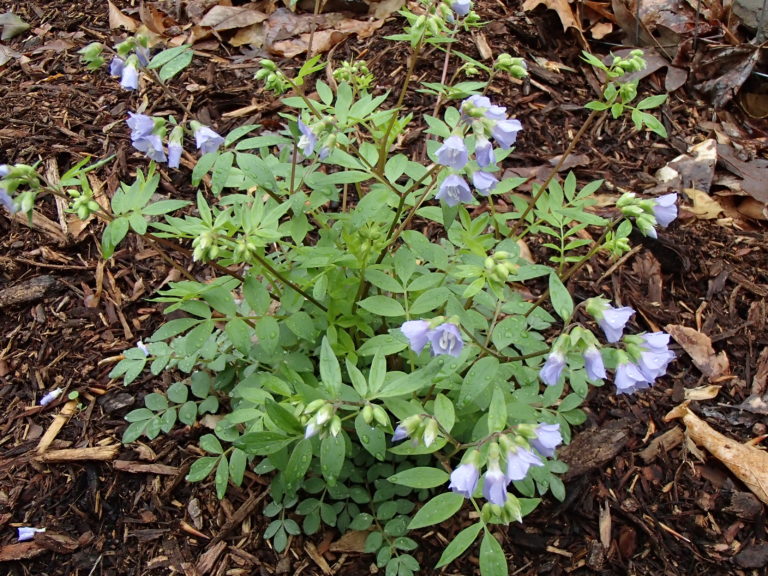Jacob’s Ladder is a sweet herbaceous perennial wildflower not common in N.C. (only in 2 counties), but native to rich, moist woodlands in much of Eastern North America. The flowers are a dainty, bright shot of blue on 1 -1.5 foot high spray of foliage in a spring garden. From April to June, tubular clusters of small blooms top delicate stems with pinnately compound leaves suggestive of a ladder’s shape. Although it is a spring ephemeral, it seems to persist vegetatively well into the summer. Best grown in light shade or dappled sun in moist, well drained, humusy soil, it can tolerate more light if it’s not too dry. This is not an aggresive plant, but since it tends to spread by self-seeding around the garden, it may develop into a light ground cover. It is reported to be deer resistant, and it attracts bees.
NURSERY HOURS
Wednesday: 10-4 Thursday: 10-6 Friday-Saturday: 10-4 Sunday: 12-4
Polemonium reptans

Key Info
Scientific Name: Polemonium reptans L.
Common Names: Spreading Jacob's-ladder, Greek Valerian
Family Names: Polemoniaceae (Phlox family)
Plant Type: Herbaceous perennial
Protected Plant Species: Yes
Leaf Retention: Deciduous
Flower Color: Blue
Additional Info
Habit: Jacob's Ladder grows as slender stalks to 1½ feet, but tends to sprawl. Flowers are borne in loose panicles at the ends of the stalks or axially. The root system consists of a short vertical crown with abundant fibrous roots. Technically rhizomatous, but this plant spreads by reseeding itself. Basal rosette.
Height: 1' - 1.5'
Spread: 1' - 1.5'
Soil Conditions: More or less mesic conditions, circumneutral pH (6.8-7.2) and moist, loamy soil with decaying organic matter.
Leaves: Alternate, odd-pinnate, comopound leaves are 8-9" long. The leaflets are elliptic, with entire margins, ¾-1¼" long and about one-third as much across. They are sessile or nearly so on their rachis, which is characteristically grooved above and convex below.
Flowers (or reproductive structures: Loose panicles of nodding flowers 1½-3" across occur at the tips of branched stems or on long peduncles in the axils of upper leaves. Individual flowers are bell-shaped, about 2/3 inch across, with 5 rounded petals that are light blue-violet with fine veins, with a greenish throat. The short calyx is composed of 5 triangular teeth; the 5 stamens have white anthers; the pistil is a slender white style that divided into three parts at the tip. The blooming period usually occurs during the late spring, lasting about 2-3 weeks.
Fruit: By mid-summer, fertilized flowers become ¼-inch, oval capsules with 3 cells containing only a few seeds.
Natural Distribution: Jacob's Ladder is found in rich, shaded, moist woods and along shady streambanks in higher quality natural habitats dominated by various deciduous trees.
USDA Hardiness Zone: 4 to 8
USDA Wetland Indicator Status in NC: FACU (FAC on Coast)
Pollination: Bees and lepidopterans pollinate the flowers.
Wildlife Connections: The nectar and pollen of the flowers attract bees primarily, including honeybees, bumblebees, little carpenter bees, mason bees, cuckoo bees, Halictid bees, and Andrenid bees; also, butterflies, skippers and moths (Illinoiswildflowers.info)
Propagation: Propagate by seed or by dividing clumps in early spring or late summer.
